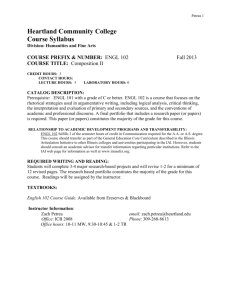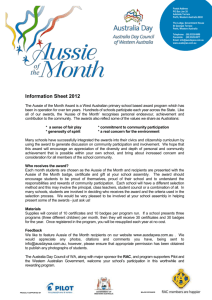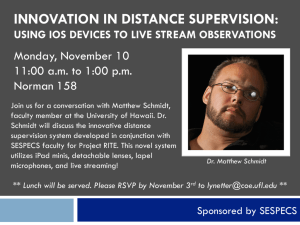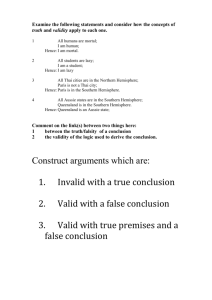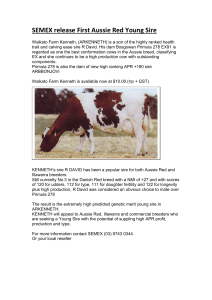Extended written response (Workplace communication): Business
advertisement
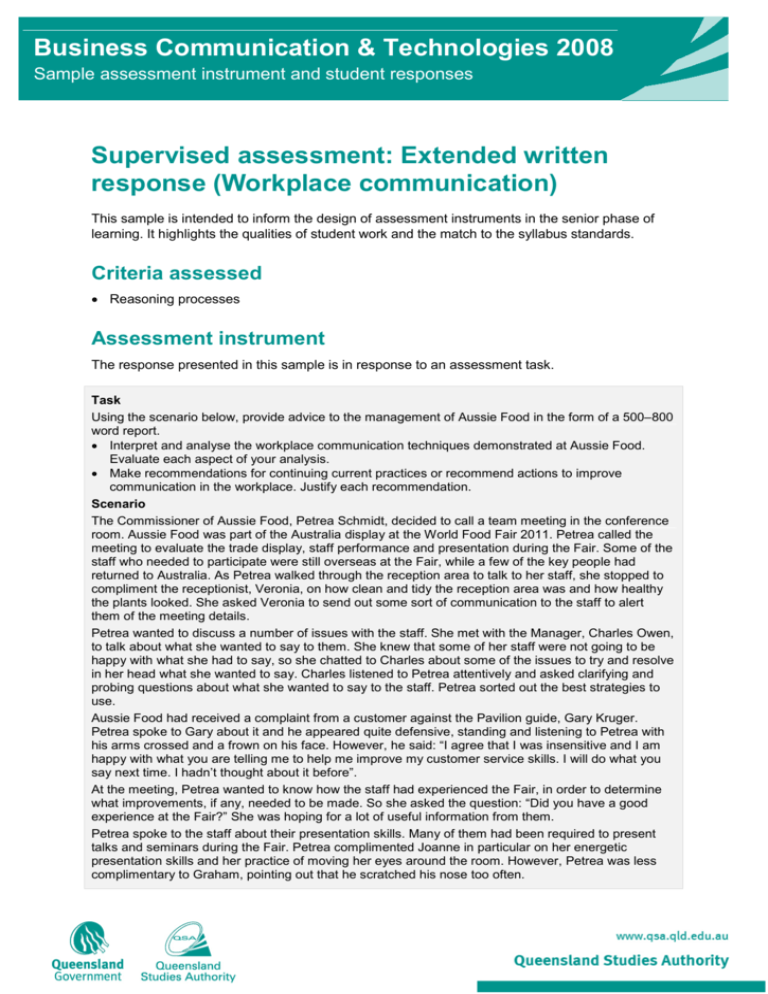
Business Communication & Technologies 2008 Sample assessment instrument and student responses Supervised assessment: Extended written response (Workplace communication) This sample is intended to inform the design of assessment instruments in the senior phase of learning. It highlights the qualities of student work and the match to the syllabus standards. Criteria assessed • Reasoning processes Assessment instrument The response presented in this sample is in response to an assessment task. Task Using the scenario below, provide advice to the management of Aussie Food in the form of a 500–800 word report. • Interpret and analyse the workplace communication techniques demonstrated at Aussie Food. Evaluate each aspect of your analysis. • Make recommendations for continuing current practices or recommend actions to improve communication in the workplace. Justify each recommendation. Scenario The Commissioner of Aussie Food, Petrea Schmidt, decided to call a team meeting in the conference room. Aussie Food was part of the Australia display at the World Food Fair 2011. Petrea called the meeting to evaluate the trade display, staff performance and presentation during the Fair. Some of the staff who needed to participate were still overseas at the Fair, while a few of the key people had returned to Australia. As Petrea walked through the reception area to talk to her staff, she stopped to compliment the receptionist, Veronia, on how clean and tidy the reception area was and how healthy the plants looked. She asked Veronia to send out some sort of communication to the staff to alert them of the meeting details. Petrea wanted to discuss a number of issues with the staff. She met with the Manager, Charles Owen, to talk about what she wanted to say to them. She knew that some of her staff were not going to be happy with what she had to say, so she chatted to Charles about some of the issues to try and resolve in her head what she wanted to say. Charles listened to Petrea attentively and asked clarifying and probing questions about what she wanted to say to the staff. Petrea sorted out the best strategies to use. Aussie Food had received a complaint from a customer against the Pavilion guide, Gary Kruger. Petrea spoke to Gary about it and he appeared quite defensive, standing and listening to Petrea with his arms crossed and a frown on his face. However, he said: “I agree that I was insensitive and I am happy with what you are telling me to help me improve my customer service skills. I will do what you say next time. I hadn’t thought about it before”. At the meeting, Petrea wanted to know how the staff had experienced the Fair, in order to determine what improvements, if any, needed to be made. So she asked the question: “Did you have a good experience at the Fair?” She was hoping for a lot of useful information from them. Petrea spoke to the staff about their presentation skills. Many of them had been required to present talks and seminars during the Fair. Petrea complimented Joanne in particular on her energetic presentation skills and her practice of moving her eyes around the room. However, Petrea was less complimentary to Graham, pointing out that he scratched his nose too often. Veronia had drafted a letter (see below) to the winner of the Aussie Food Competition, which had been running in recent months. The winner was to receive an Australian landscape painting and a hamper of Australiana items. Veronia wanted to know if the letter was appropriate to send to the winner, and asked Charles to look at it for her. Petrea thanked all the staff for their enthusiasm and their ongoing commitment to their jobs and to Aussie Food. 2 | Business Communication & Technologies 2008: Sample student assessment and responses Instrument-specific criteria and standards Student responses have been matched to instrument-specific criteria and standards; those which best describe the student work in this sample are shown below. For more information about the syllabus dimensions and standards descriptors, see www.qsa.qld.edu.au/5699.html. Reasoning processes Standard A Standard C The student work has the following characteristics: The student work has the following characteristics: • effective and consistent interpretation, analysis, synthesis and evaluation of information • basic interpretation, analysis, synthesis and evaluation of information • development of logically reasoned arguments, valid conclusions, appropriate and justified recommendations to business-related issues and problems • development of reasoned arguments, conclusions and recommendations to business-related issues and problems • communicates information consistently and effectively to a business standard for a variety of purposes and audiences. • communicates information for a variety of purposes and audiences. Note: Colour highlights have been used in the table to emphasise the qualities that discriminate between the standards. Queensland Studies Authority February 2012 | 3 Student response — Standard A The annotations show the match to the instrument-specific standards. Comments Communicates information consistently and effectively to a business standard for a purpose and audience. Effective communication with businesses and workplaces is vital. It is essential for colleagues to be able to demonstrate effective communication skills within a workplace for the business to run efficiently. Communication covers verbal and nonverbal as well as written forms such as email. The Commissioner of Aussie Food, Petrea Schmidt, is holding a team meeting about the company’s recent experiences at the World Food Fair 2011. This report will analyse the workplace communication techniques demonstrated by Aussie Food employees and outline which techniques should continue to be used. Recommendations to improve workplace communication will also be made. Team meetings Effective and consistent interpretation, analysis, synthesis and evaluation of information Development of logically reasoned arguments, appropriate and justified recommendations to a business-related problem Inclusion of headings adds structure to the report — demonstrates student is able to communicate effectively. It is constructive that Petrea has decided to host a team meeting. A staff meeting is an effective way for staff to share their experiences and thoughts. Through face to face communication, decisions can be made instantly on issues and improvements. It also provides staff with the opportunity to have their views heard and fosters a team environment as staff feel their opinions are valued. It is recommended that Petrea continues to hold team meetings. It is important that all staff members attend team meetings as they are beneficial and require the input of everyone which can improve efficiency and ultimately productivity. It is advised that Petrea ensures that all members still overseas or unable to personally attend the meeting are still able to participate. Petrea could set up the team meeting with a webinar so members unable to attend personally can still actively participate in the meeting via video. Another alternative could be that the meeting is streamed through a live podcast or webcast so other members can still listen to what is being discussed. Through creating alternatives for members unable to personally attend but still participate in meetings, everyone is included. Reception It was encouraging of Petrea to comment on the clean state of the reception area to the receptionist as it provides the first impression of a business for customers. A good first impression will assist in fostering Aussie Food’s reputation resulting in an increase in both customers and profit. Listening skills Effective and consistent interpretation, analysis, synthesis and evaluation of information The manager, Charles Owen, demonstrated reflective listening skills when Petrea was talking to him about her concerns regarding the team meeting. Reflective listening would benefit the staff at Aussie Foods, as understanding each other’s points of view will assist staff to feel supported and their opinions valued resulting in higher staff morale and increased productivity. Customer complaints It is unfortunate Aussie Foods received a complaint about the Pavilion guide, Gary Kruger, from a customer. However it is appropriate that Petrea addressed him about the issue. Gary should not have responded to Petrea defensively. Instead he should have applied an assertive response to dealing with the criticism. Although Gary responded to the criticism passively, agreeing with everything Petrea was saying, his body language implied something different. Gary’s crossed arms and the frown on his face whilst talking to Petrea implied that he was annoyed and aggressive towards her. Despite body language being nonverbal, it can 4 | Business Communication & Technologies 2008: Sample student assessment and responses still speak louder than words. This can result in miscommunication due to the mixed messages being sent. Therefore it is recommended that Gary practices more assertive responses to criticism and is mindful that his body language is congruent with what he is saying. This is important to avoid miscommunication and to maintain staff relationships which will improve staff productivity. Questioning Effective and consistent interpretation, analysis, synthesis and evaluation of information Petrea wanting to ascertain feedback on the staff’s experiences is an active and positive way to look for improvements. However the question Petrea asked in order to gain information was not effective as it was a closed question. Asking a closed question only allows for a yes or no response to be given which results in limited information being able to be obtained. It is recommended that Petrea asks open questions which allow for extensive responses to gain a better understanding of where improvements can be made. Using open questions will allow for more useful communication, which will feed into future performance that will be more likely to meet customer needs. Interpersonal skills Development of logically reasoned arguments, appropriate and justified recommendations to a business-related problem Petrea positively commented on the presentation skills of Joanne however it would have been more constructive for the other staff if she had gone into more detail about how her energetic skills were effectively demonstrating connection with the audience. Joanne’s passion and enthusiasm in her presentation would promote audience attentiveness and therefore a clear delivery of the message. Although Graham needed to be informed about his poor communication skills, it would have been more appropriate for Petrea to show tact and discretion by addressing him personally rather than in front of the staff. Graham would have felt demeaned in front of his colleagues, having an impact on his confidence and work ethic in the future. By Petrea displaying more discretion and tact, she would show more respect for Graham and other members of staff, thereby maintaining staff morale and work ethic. It is positive that Petra thanked her staff for their work at the fair as it encourages staff to continue doing well. This encouragement may increase staff productivity. Correspondence The letter Veronia drafted had many mistakes in the formatting and expression. The letterhead should have been placed to the right of the page and the email address under the rest of the contact details. The city and subject line should be formatted in bold and the actual date included. Although the meaning was clear, her expression was poor as she used unprofessional phrases that were not of a business standard, and unnecessary descriptive words. The language used is persuasive and would be more appropriate for other less formal mediums. Veronia also did not end the letter correctly with her full name and business title. It is recommended that Veronia uses concise and formal business language in letters. This then displays a professional image of Aussie Food to the customer, which may contribute to the expansion of the client base. Communicates information consistently and effectively to a business standard for a purpose and audience. In conclusion, if all recommendations made are followed, Petrea and her staff will be able to communicate more effectively with one another and hold effective and beneficial staff meetings. Petrea will also improve her ability to deal with employee issues and continue to motivate her staff to work to the best of their ability. Staff members will also improve their workplace relationships with one another through the use of assertive and effective communication skills with one another. Following these recommendations will allow greater customer satisfaction, which will have a positive impact on the profit of Aussie Food. Queensland Studies Authority February 2012 | 5 Student response — Standard C The annotations show the match to the instrument-specific standards. Comments Communicates information for a purpose and audience. Basic interpretation, analysis, synthesis and evaluation of information At the 2011 World Food Fair, the company, Aussie Food, showcased their own display leaving customers with a taste of Australian food from the company. The Commissioner, Petrea Schmidt, has arranged for there to be a staff meeting next Monday in order to discuss the Expo. These matters include the evaluation of the trade display, staff performance and also presentation during the World Food Fair. The following is a detailed analysis of the workplace communication at Aussie Food and recommendations for the actions which should or could have been taken to improve communication, and continue the current practices of the company. The first matter of action is to do with the lack of staff which shall be present at the arranged staff meeting due to their absence overseas as they are still working at the Fair. It is important that all staff have the opportunity to have their say so a staff meeting is a good idea. In order for every staff member to have a say in the evaluation meeting, a webinar session must be held. A webinar allows staff, customers or guests, no matter the distance, to participate in a conference via a webcam. An appropriate room and setting must be surrounding and audio and visual equipment must all be ensured to be working. Plenty of notice must also be given to overseas staff in order to prepare for the meeting, which is the second point. Petrea Schmidt has requested that the receptionist of Aussie Food send out some sort of communication to the staff to alert them of the meeting details. Due to the fact that there are staff that need to be present who are currently overseas, this request must be placed at the top of the priority for the day’s duties in order for preparation time. An appropriate type of communication that should be used is a memo. A memo (or memorandum) is used to communicate between staff within a business and is sent to the employee’s workplace email account. An ideal memo would be: “All employees, It is requested by the Aussie Food Commissioner, Petrea Schmidt, that a staff meeting will be held next Monday (20 June 2011) at 10 am in the conference room. All currently deployed staff will attend via webinar.” Development of reasoned arguments and recommendations to a business-related problem This allows all employees to be notified of the date, time, who will attend and where the meeting will be held. To prepare for this, Petrea Schmidt has discussed with Manager, Charles Owen, which comes to the third issue. Mrs Schmidt wishes to discuss some issues that she believes some of her employees may not be happy with. Recently, Aussie Food has received a complaint from a customer against the Pavilion Guide, Gary Kruger, and when confronted Mr Kruger seemed defensive about the situation as he stood with his arms crossed and a frown. This can often give the impression that an employee is unwillingly listening to the topic, otherwise known as aggressiveness. Aggressiveness can include such actions such as closed body language or defensive responses, however Gary Kruger’s response was not defensive. Mr Kruger has admitted to his actions and has assured Mrs Schmidt that he will improve on his skills as she has successfully communicated the issue – a passive response. 6 | Business Communication & Technologies 2008: Sample student assessment and responses Basic interpretation, analysis, synthesis and evaluation of information Development of reasoned arguments and recommendations to a business-related problem Whilst at the meeting Petrea Schmidt wished to attain information about the stall at the World Food Fair in order to be aware of any improvements that needed to be made for future reference. The question was as follows: “Did you have a good experience at the Fair?” From this answer, a basic “yes” or “no” would be given, thus resulting in an unhelpful response. Using a closed question does not provide much information. In order to gain the feedback needed, Mrs Schmidt needs to raise an exploring question as an exploring question gives the staff the opportunity to give their views, opinions and experiences on the Fair. A more ideal question could have been, “I would like to know what everyone’s views, opinions and experiences were on the World Food Fair so we can improve on anything needed for next year.” This allows employees to voice their opinions of the Expo and also allows Petrea Schmidt to gain feedback to help in planning next year’s event. Joanne has been complimented on her presentation skills which were energetic, unlike Graham who tends to have the habit of scratching his nose. For Mrs Schmidt to gain a better presentation from Graham, a private conversation can be held between the two as it is less embarrassing and humiliating for the employee. Mrs Schmidt can ensure Graham that not all employees are comfortable talking in front of an audience and if he would prefer then he could start doing smaller Expos to build up his confidence. Communicates information for a purpose and audience. Finally, the last point relates to the letter drafted by Veronia to the winner of the Aussie Food competition. To begin with, the website should be named in the header, the date should be entered, and the city and postal address should all be fully bolded with double spacing between the city and postcode. In the content, the letter is wordy and informal, e.g. “overwhelmingly happy and delighted”, “as you very well know”, “fantastic and brilliantly designed”, “a jolly large hamper”. There should be no extra description, and simple, formal words should be used. To end the letter, there should be “Yours sincerely” instead of the casual “Cheers”. The letter sent to Mr Sa should not be signed by Veronia, but rather the Commissioner of the company, Petrea Schmidt or the Manager, Charles Owen. From these issues, the Aussie Food company is able to gain feedback and improve on any future problems. Each situation has been assessed and evaluated and a recommendation has been given, which if followed, should help to increase the Aussie Food sales. Each staff member who has been evaluated on their presentations should be given reasonable feedback in an assertive tone and language in order to allow for successful improvement. Acknowledgments The QSA acknowledges the contribution of St Ursula’s College, Toowoomba, in the preparation of this document. Queensland Studies Authority February 2012 | 7

